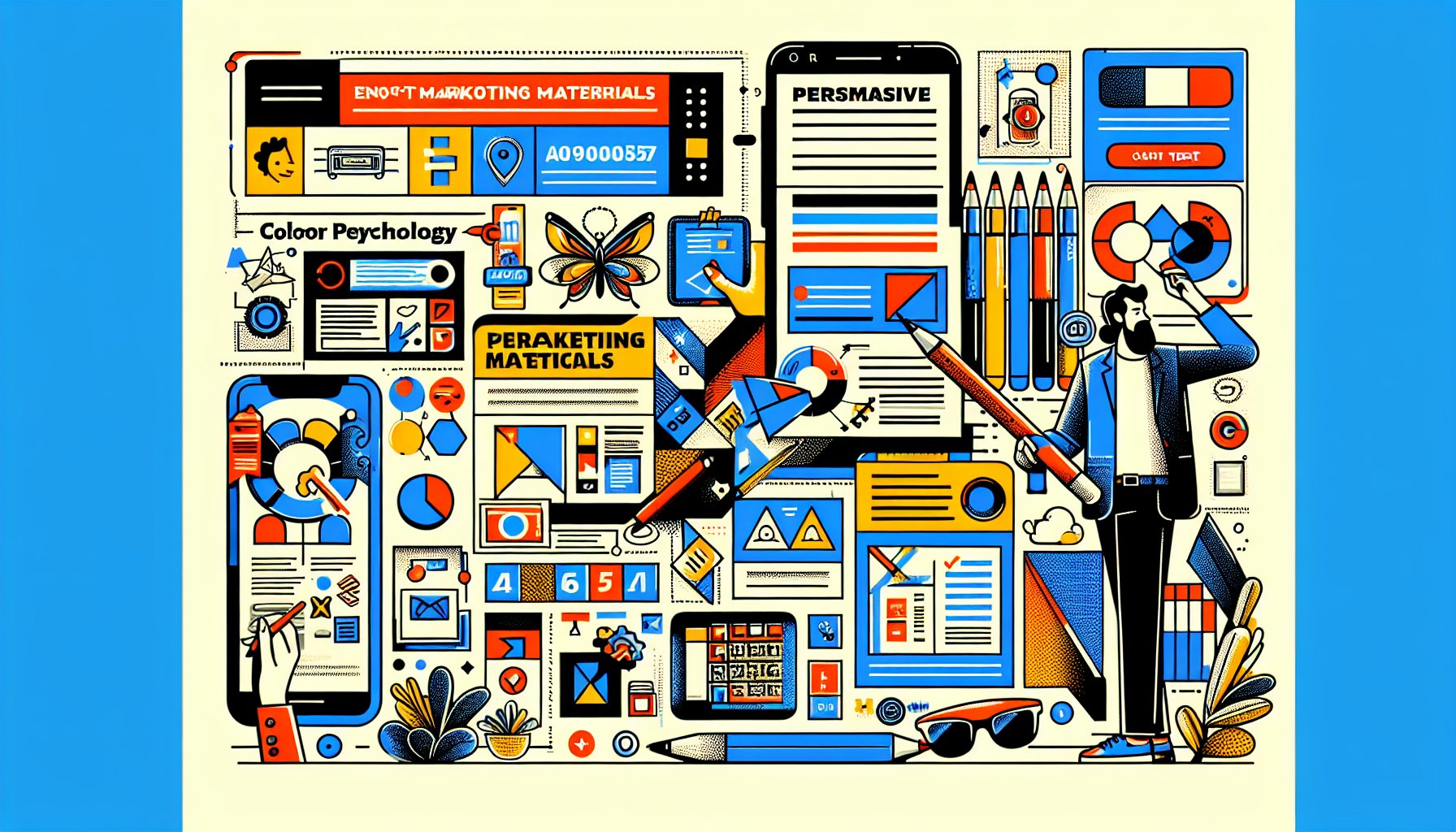Marketing Materials
How to Write Persuasive Copy for Your Marketing Materials
Unlock the secrets to crafting persuasive copy that captivates and converts. Discover essential techniques, storytelling strategies, and audience insights to elevate your marketing materials and drive engagement.
Sep 05, 2025
16 min read

How to Write Persuasive Copy for Your Marketing Materials
TL;DR Summary
In the lightning-fast world of marketing, where attention spans barely rival goldfish, the secret sauce of success is persuasive copy. It's not just about pretty words; it's connecting on an emotional hotline with your audience. This isn't your run-of-the-mill guide. No, this is your witty, tell-it-like-it-is roadmap to crafting copy that doesn't just get noticed but converts casual scrollers into loyal brand advocates. Buckle up for a journey through audience insights, storytelling magic, and the delicate balance of ethics in persuasion. Let's dive in.
Crafting Captivating Copy: The Art of Persuasion in Marketing Materials
In today's blink-and-you-miss-it marketing landscape, the skill of writing persuasive copy is your brand’s secret weapon. At its heart, it's about weaving emotional connections with your audience while still delivering a crystal-clear value proposition. Let's embark on this journey of turning everyday copy into a catalyst for action.
First things first: know thy audience. Dive deep into their dreams, fears, and desires. Understand their pain points like you're reading their diary. Picture this: you're part of a marketing team for a new fitness app. Instead of just boasting about features like workout tracking, focus on the emotional perks: feeling healthier, more energetic, or part of a community. When you tap into these emotional aspects, your copy becomes a mirror reflecting your reader's aspirations and dreams.
But understanding alone isn't enough. It's time to structure your message like an epic story. Take a leaf out of the Proforma Color Press playbook: don't just list services. Spin a story about a small business owner struggling with visibility who finds salvation through creative design. Such storytelling not only grabs attention but also paints a picture where readers see themselves in the narrative.
Now, let’s talk language. Every word should have purpose and power. Action-oriented verbs and a dash of urgency can supercharge your copy. Phrases like "Limited time offer" or "Transform your brand today" light fires under your readers. Pair these with strong calls to action, and you'll guide your audience smoothly toward their next step, whether that’s subscribing to a newsletter, booking a consultation, or buying a product.
Beware, though: the path is fraught with pitfalls. Overload your message with jargon, and you'll alienate potential customers. Strike a balance between professionalism and accessibility. The language should be engaging yet comprehensible. And don’t be afraid to test different versions of your copy using A/B testing to find what truly resonates.
Ultimately, persuasive copywriting is a journey of empathy, creativity, and strategy. Brands like Proforma Color Press show us that captivating copy can transform not just marketing materials but the trajectory of a business. Craft narratives that connect emotionally, use strategic language, and continually refine your approach. In a world where great ideas jostle for attention, remarkable copy is your golden ticket to standing out and driving genuine engagement.
The Persuasion Paradigm: Understanding Human Psychology
At the heart of persuasive copy lies intricate human psychology. It’s about more than just selecting the right words; it’s about diving deep into the emotions, needs, and motivations driving human behavior. Remember, each potential customer is not a mere data point; they're individuals with fears, desires, and values.
Take recruiting top talent as an example. Instead of listing job qualifications, highlight emotional benefits, career growth, work-life balance, and a company culture that values innovation. Frame the opportunity to resonate with their aspirations, turning a mundane listing into a compelling call to action.
For those in marketing, it's crucial to wield storytelling that resonates personally with your audience. Perhaps share the journey of someone who found empowerment through a fitness program instead of merely promoting physical results. Such narratives make your message relatable and encourage readers to visualize their transformation.
Harness the principles of scarcity and social proof, too. A limited-time offer presented alongside satisfied customer testimonials creates urgency and prompts quick action. Remember, the art of persuasion is a dynamic blend of understanding psychology, crafting relatable narratives, and addressing needs. With this approach, marketers can capture attention and drive action, resulting in higher conversion rates and brand engagement.
Audience Alchemy: Transforming Demographics into Personas
To master persuasive copywriting, one must delve into the realm of the audience. It's not enough to identify demographics, age, income, gender, or geographic location. You must transform these statistics into vibrant personas that fuel a powerhouse of persuasion.
Take Proforma Color Press, for instance. Targeting "business owners" wasn't enough; they imagined Sarah, a 35-year-old marketing manager seeking innovative promotional materials. They knew Sarah was tech-savvy, valued creativity, and often felt overwhelmed by choices. By personifying their audience, Proforma could tailor messaging to resonate with Sarah’s specific challenges.
Common pitfalls arise when marketers focus on data and neglect the human element. Stark demographic profiles can't capture individual experiences. Engage with your audience, conduct surveys, gather feedback, participate in social media conversations. This effort refines personas, ensuring they're dynamic reflections of real people with real desires.
Crafting copy that connects with these transformed personas hinges on evoking feelings, stimulating imaginations, and calling to action. When offerings align with authentic audience needs, you create a persuasive marketing narrative that is truly transformative.
Words that Dance: The Power of Language and Storytelling
In marketing, language isn't just a tool; it’s an intricate dance of persuasion, emotion, and connection. Each word carries the weight of intention and potential to inspire action. At Proforma Color Press, we recognize that great copy doesn't just inform, it captivates. It creates narratives that resonate and drive action.
Storytelling is an essential ingredient. Invite your audience into a world where they can see themselves. Instead of listing features, illustrate a scenario. Picture Sarah, a small business owner overwhelmed with daily operations, who finds a partner in your service. Through her journey, your audience sees themselves, creating an emotional connection that statistics can’t achieve.
The potency of language lies in nuances. Words like "discover," "transform," and "experience" don't just describe actions; they evoke feelings, stir curiosity, and create anticipation. When telling a story about increased engagement after reimagining design, you're inviting readers to envision similar success for themselves.
Recognize that language’s dance can sometimes stumble. Avoid jargon and complexity that alienate your audience. Focus on clarity and relatability. Words should engage without requiring a dictionary.
Ultimately, the power of language and storytelling lies in keeping your audience engaged and invested. Words that dance together create a melody that resonates and drives action. Proforma Color Press doesn’t just write copy; we tell your story in ways that captivate and convert.
The Six-Step Formula: Crafting Your Persuasive Message
At the core of persuasive copy is a connection that transcends mere words. The Six-Step Formula is your strategic guide to engaging readers, sparking interest, and compelling them to act.
Start with a deep understanding of your audience. Go beyond demographics to explore their pain points, desires, and motivations. Picture a small business owner overwhelmed with choices. Craft your message as a personal, effective solution supported by data and tools.
Next, focus on your USP. Highlight what makes your product or service different in a way that resonates with audience aspirations. For example, emphasize how your recruitment service reduces hiring hassle, allowing businesses to excel in selling.
Define your audience, clarify your USP, and articulate a compelling narrative. Use storytelling to paint vivid pictures of transformations enabled by your offerings. This builds trust and relatability.
Maintain clarity and simplicity. Communicate in a tone that’s approachable yet authoritative. Ditch jargon that alienates potential customers. Guide readers with engaging, dynamic content.
Incorporate a strong CTA. Don’t just say "Contact us." Instead, excite your audience with prospects like "Unlock your business’s potential, schedule a free consultation today!" Make actions feel like opportunities.
Finally, review and refine. Crafting persuasive copy is iterative. Gather feedback, conduct A/B testing, analyze performance. Optimize messaging for audience expectations and industry trends.
By weaving understanding with clarity, storytelling, and engagement, you create messages that resonate and drive meaningful action towards your marketing goals.
Visual Versus Verbal: The Synergy of Design and Copy
In the marketing arena, where attention spans are short and competition is intense, the interplay between design and copy is more than a consideration, it’s a powerful synergy. Companies like Proforma Color Press understand that messaging is encapsulated not just in words but in how those words are visually presented.
Imagine a promotional brochure with captivating copy about a new service. Without a visual framework, thoughtful typography, effective color use, engaging imagery, the message can fall flat. Consumers process visuals faster than text, so visual elements must reinforce the copy’s intent. A striking image paired with a bold headline can evoke reactions words alone may not, turning passive readers into engaged prospects.
This synergy isn't about aesthetics; it's alignment. Visual elements should amplify, not compete with, the copy. A sleek, minimalist design with high-resolution images reinforces a premium product. Conversely, cluttered layouts risk losing audience interest altogether. A seamless experience, where design enhances comprehension and recall, is crucial.
Consider digital marketing. Websites and landing pages with appealing designs show higher engagement. A well-crafted CTA, highlighted with contrasting colors and strategic placement, can significantly boost conversion. If lost in text or poorly integrated, even compelling copy may go unnoticed.
Collaboration between designers and copywriters is key. This process should be iterative, not a hand-off. Workshops and brainstorming yield innovative concepts valuing both visual and verbal elements. By fostering this collaboration, businesses create marketing materials that inform and inspire action.
In this modern landscape, the marriage of design and copy isn’t just beneficial; it’s essential. To captivate and convert, every marketing piece must embrace this synergy, ensuring visual and verbal narratives weave into a cohesive story that resonates with the audience.
The Testing Ground: Iterating Copy for Maximum Impact
In the whirlwind world of marketing, crafting persuasive copy is akin to fine-tuning a musical instrument. It demands precision, patience, and an unwavering commitment to iterative improvement. At Proforma Color Press, effective marketing lies in understanding that the first draft is just a stepping stone, the real magic unfolds in the testing ground, where words are continuously refined for maximum impact.
Picture drafting a compelling email to capture leads for your next big campaign. You spend hours selecting the perfect words and tone, confident you’ve struck the right chord. But once sent, you encounter a disappointing conversion rate. It's a familiar scenario for marketers, highlighting a crucial lesson: great copy doesn't emerge from inspiration alone; it thrives in an environment of continuous testing and iteration.
Start by gathering actionable data. A/B test different headlines for more opens or experiment with varying CTAs to see what prompts clicks. For instance, one company found that changing "Sign Up Now" to "Unlock Your Exclusive Offer" led to a significant increase in sign-ups. These insights aren't just numbers; they tell a story about audience preferences and motivations.
Feedback channels are equally vital. Engage with your audience through surveys or social media to unveil invaluable insights. Perhaps readers prefer personal anecdotes over generic statements or respond better to data-driven arguments than emotional appeals. Listening to your audience transforms your copy from a monologue to a dialogue, crafting truly resonant messages.
Beyond analyzing metrics, make the revision process an art form. Embrace clarity and simplicity. Marketers often fall into jargon traps, thinking they impress audiences. Yet, what truly impresses is straightforward, relatable language. Consider how often your message might be misunderstood; a simpler approach often results in a stronger connection.
The iterative cycle doesn’t end after refining your copy. It’s a living process, requiring continual revisiting as trends shift and audiences evolve. Explore new strategies and tools, such as advanced analytics or machine learning algorithms, and be prepared to pivot and adapt messaging based on real-time feedback.
Ultimately, the testing ground is where marketing efforts culminate into impact. It's not just about writing persuasive copy but evolving it. Understand your audience deeply, learn and adapt continuously. This approach not only enhances lead generation or drives sales; it builds a long-lasting connection between your brand and its audience, rooted in understanding, trust, and mutual benefit. At Proforma Color Press, we recognize that it’s not just about grabbing attention; it’s about keeping it, one iteration at a time.
Ethics in Persuasion: Staying True to Your Brand Voice
In the art of persuasive copywriting, balancing ethics and intent is essential. For brands like Proforma Color Press, where trust is paramount, staying true to your brand voice is more than a strategic edge, it’s an ethical duty. Authenticity in messaging forms the cornerstone of credibility and effectiveness. A gap between proclaimed values and produced copy can lead to disillusionment for prospects and existing customers.
Consider assertive claims promising astounding results, like "Better data, better tools, better revenue results." While persuasive, they must resonate with genuine capabilities. If products or services fall short, repercussions are immediate: customer dissatisfaction, negative reviews, and a tarnished reputation. Instead, crafting narratives that reflect a genuine market understanding, embracing transparency about realistic achievements, enhances trustworthiness. For example, instead of claiming "drive inbound leads that convert," illustrate case studies or testimonials showcasing proven success.
Consistency in voice and tone across communications maintains brand integrity. Marketing copy should mirror values expressed through customer service interactions, social media, and internal communications. If Proforma positions itself as a leader in innovative solutions, the copy must reflect a forward-thinking, confident tone, yet remain approachable and supportive. The goal is to create an omnichannel experience where every touchpoint reinforces the same message and values.
Ethical persuasion also involves empathy. Understand audience pain points and address them without manipulation to create authentic connections. Ask yourself: Does this copy genuinely serve reader needs and help informed decisions? For instance, when promoting standout design services, highlight not only aesthetic appeal but business impact, how “creative that converts” translates to ROI.
Ethical persuasion is aligning efforts with brand voice and values. Even engaging copy loses power if it lacks authenticity. Persuasion becomes about building lasting relationships rooted in trust and transparency. Ensure that the voice projected in marketing materials aligns consistently with brand essence, fostering credibility and loyalty.
The Future of Persuasive Copy: Adaptation in a Digital Age
As we stand at the forefront of an increasingly digital landscape, persuasive copywriting is undergoing a transformation. The future of this craft isn't just about writing compelling text; it’s about weaving narratives that resonate with real-time data, audience engagement, and technology shaping consumer behavior. Companies like Proforma Color Press exemplify this shift toward a data-driven approach in crafting marketing materials, reflecting a broader trend across industries.
In a world inundated with information, the challenge lies in cutting through noise. This is where traditional techniques meet innovative technology. Advanced analytics allow marketers to glean insights from consumer behaviors and preferences at unprecedented scales. Target specific demographics with personalized, relevant messaging. For instance, data-driven copy can shift from generic calls to action to tailored prompts that speak directly to individual interests and pain points, enhancing conversion likelihood. Effective copywriting has evolved into a strategic fusion of art and science, where understanding metrics informs creativity.
The digital age has ushered in immediacy. Prospects aren't just passive recipients; they're active dialogue participants. Engaging copy must invite interaction, encouraging users to consume and share content within networks. This leap in persuasive writing is akin to inbound marketing, creating a brand experience, not just selling a product. Companies use storytelling, blogs, videos, social media posts, to create emotional connections that drive loyalty. Brands resonating emotionally with audiences typically see higher retention rates.
As technology advances, so does creativity. Strategic thinking combined with standout design is a potent weapon in marketers’ arsenals. Integrating visual elements that complement persuasive text enhances engagement rates. Take Proforma’s approach: creative services aren’t afterthoughts but critical components of strategy. Standout design reinforces brand identity while making messages memorable.
Ultimately, the future of persuasive copy is defined by adaptability. As consumer behaviors shift and new platforms emerge, copywriters must embrace change, harnessing new tools and techniques to remain relevant. Adapting in this dynamic environment fosters lead generation, conversion, and deeper brand-audience connections. Those mastering art and change in persuasive copy will thrive in marketing's future.
The Proforma Playbook: Your Roadmap to Persuasive Copywriting
Facing a blank page can feel daunting, but don’t worry, you’re not alone. Crafting compelling marketing materials isn’t just an art; it’s a systematic process that, when mastered, can transform casual readers into loyal customers. Enter the Proforma Playbook: your guiding light through the intricate landscape of persuasive copywriting, equipping you with tools and approaches to generate leads and boost conversion rates.
Start with audience understanding. Go beyond demographics; delve into the psyche of your target market. What keeps them up at night? What are their aspirations? Tailor messaging to resonate with their pain points and dreams. If your audience is young professionals seeking career advancement, the copy shouldn’t just promote a product but highlight how it helps them achieve goals faster and more efficiently.
Next: storytelling, indispensable for persuasion. Good copy grabs attention; great copy creates emotional connections. Weave narratives to illustrate product or service impacts. Picture a shoe brand sharing a customer’s journey from foot pain to relief. This showcases product benefits and humanizes the brand, making it relatable and trustworthy.
In persuasion, clarity is paramount. Audiences are bombarded with information; your message must cut through noise. Use clear, concise language guiding readers effortlessly toward desired actions. Avoid jargon, adopting a conversational tone that feels inviting.
The importance of a strong call to action (CTA) can’t be overstated. Your engaging copy must culminate in actionable steps. Encourage clicks, form fills, or purchases. Combine CTAs with high-impact design and visuals amplifying messages, creating materials that look professional and drive engagement.
Embark on this copywriting journey with continuous testing and iteration. Analyze user behavior, gather feedback, refine messaging based on real-world results. This cyclical process enhances copy, aligning it with evolving audience needs.
With the Proforma Playbook as your roadmap, transform copy into a powerful engagement and conversion vehicle. Dive into audience desires, craft narratives, maintain clarity, and call readers to action. Enhance marketing materials and establish lasting audience connections driving measurable success.
Voices of Experience
Navigating persuasive copywriting's diverse landscapes benefits from hearing seasoned experts. We spoke with several copywriting aficionados, gaining unique insights to help marketers craft compelling, action-driving narratives.
Mark Thompson, a veteran copywriter blending storytelling and strategy, emphasizes empathy in copywriting. “I step into readers' shoes,” he explains. “What keeps them up at night? What solutions do they seek?” This empathetic approach is the heart of persuasive copy. He recalls a wellness brand campaign, deeply researching emotional hurdles customers faced. Crafting resonant messages led to a significant engagement and conversion uptick.
Lisa Chang, a digital marketing strategist renowned for high-converting landing pages, states clarity is paramount. “Your audience should immediately understand your offer and its importance,” she asserts. Great copywriters distill complex ideas into simple, impactful statements. Lisa's promotion of a tech tool focused on time and productivity benefits, avoiding technicalities, achieving a 40% lead generation increase, showcasing clarity's power.
David Reyes, creative director,
Need Help?
Check out these related products that can help:









